Ken Burns: ‘I do not accept that only people of a particular background can tell certain stories’
Famed documentarian Ken Burns said Wednesday that he applauds new measures announced by PBS to increase the diversity of its programming, which come after filmmakers of color complained that white producers like Burns were getting an outsize amount of public TV’s airtime and tackling topics, such as Muhammad Ali, that should be the province of Black filmmakers.
Burns spoke during a session on his new documentary, Muhammad Ali, during the second day of PBS’ portion of the online Television Critics Association annual summer press tour. The film is scheduled to air Sept. 19–22.
Burns pointed out that 40% of his crew were people of color and that 53% were women. He said the percentages were similar to those of his crews going back 25 years.
“I’m in the business of history, and that includes everyone,” Burns said. “And I have, throughout my professional life, tried to tell the story of the country in an inclusive way. That means talking about race and trying to tell stories from multiple perspectives.”
The filmmaker said he encourages others to tell their own stories. “But,” he added, “I do not accept that only people of a particular background can tell certain stories about our past, particularly in the United States of America.”
Comments by filmmakers of color come “from an important and incredibly true impulse,” Burns said. “And we have to honor it.” He said producers should think about and accept PBS’ new diversity guidelines, which will result in more empowerment, more representation and more stories being told.
“We look forward to all the stories that can be told, and the only place that’s truly interested in a variety of these perspectives and these stories is PBS,” Burns added. They “have taken the steps necessary to begin the progress forward, which is the only direction I plan to head in,” he said.
COVID causes ‘Masterpiece’ delays
During other PBS sessions:
• Sonia Manzana, famous to generations of Sesame Street viewers as Maria, confessed to a misdemeanor while discussing her new PBS Kids show, Almas’s Way.
When she was just seven or eight years old, Manzana was well aware of how tight money was in her household. Though her mother gave her a nickel to buy candy, she stole the candy instead. When she got home, she boasted to her mother that she had saved a nickel.
Her mother told her they could afford the candy and that she must not steal, Manzana said.
Her new show, which premieres Oct. 4, is mostly about teaching children to think. She said her idea to steal the candy meant she had thought about the situation. “I didn’t come up with the right solution, but I did think,” she said.
Manzano said it took five years to develop the animated show, starring a six-year-old Puerto Rican girl growing up in the Bronx. All of the characters are based on friends and relatives.
• Viking Cruises, a key supporter of Masterpiece for a decade, has extended its sponsorship for two more years, said series EP Susanne Simpson.
Simpson said three Masterpiece series — Sanditon, Endeavour and Van der Valk — faced production delays because of the COVID-19 virus and won’t be seen until next year. Grantchester was moved from summer to fall.
• Yamiche Alcindor, who became moderator of Washington Week in May, said her weekly roundtable discussion is unlike the panels featured day in and day out on cable news channels. Instead of academic scholars, former government workers and analysts on retainers, Washington Week features premier journalists from widely respected news organizations.
“Nowhere else on TV are you going to see the top White House reporters or the top correspondents from different networks sitting down at the same table,” she said. “You are not going to see the chief White House correspondent for CNN talking to the chief legal analyst of NBC talking to the chief White House correspondent for The Washington Post and then the health reporter for The Atlantic.”
“I think that’s what makes us unique,” Alcindor said. “I think it’s great that the other networks recognize that Washington Week is a place they want to send their journalists.”
• As powerful as media tycoon Rupert Murdoch is, his empire doesn’t match the one assembled by William Randolph Hearst, said Gary Kamiya, a journalist and historian featured on the American Experience profile of Citizen Hearst to be broadcast Sept. 27 and 28. “I don’t think Murdoch can equal Hearst’s sheer range and control of the media landscape,” he said.
Both media barons played fast and loose with the truth and practiced advocacy journalism, Kamiya said, but Hearst also had the ear of presidents.
When newsreels brought a video dimension to accounts of current events, Hearst opened an all-newsreel theater in New York, said Stephen Ives, writer and director. “It was really like a prototype of CNN,” Ives said.






